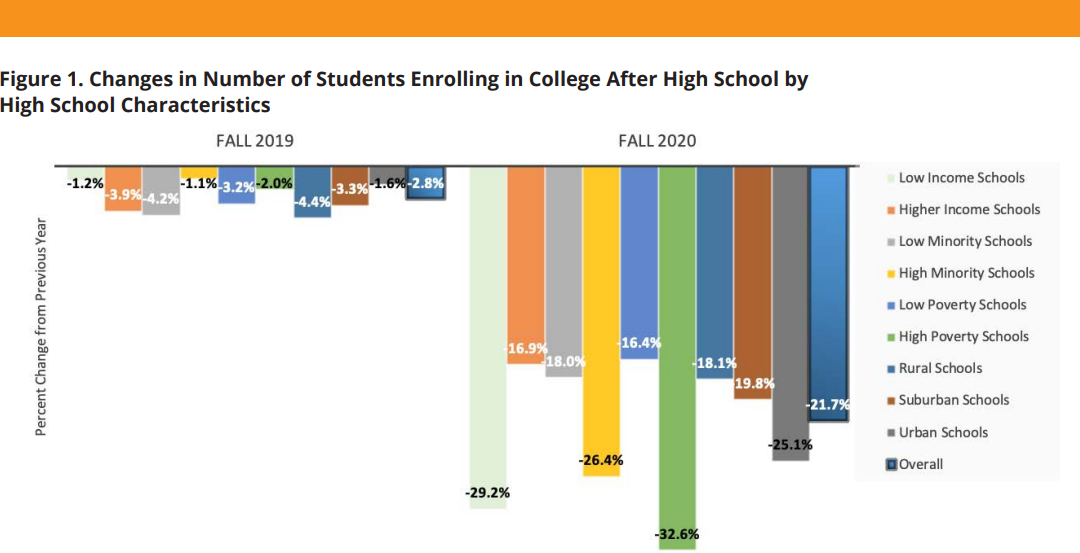 In late 2020, National Student Clearinghouse released a new report examining high school graduates’ transition to postsecondary education. This COVID-19 Special Analysis looks at 2020 high school graduate college enrollment using preliminary data from 2,324 high schools. Though the data are not a nationally representative sample, the report identifies several key takeaways from these early numbers. Most importantly, while high school graduation was relatively unaffected by COVID-19, far fewer graduates went to college immediately after high school in the fall of 2020 — a decline of 21.7% compared to the previous year.
In late 2020, National Student Clearinghouse released a new report examining high school graduates’ transition to postsecondary education. This COVID-19 Special Analysis looks at 2020 high school graduate college enrollment using preliminary data from 2,324 high schools. Though the data are not a nationally representative sample, the report identifies several key takeaways from these early numbers. Most importantly, while high school graduation was relatively unaffected by COVID-19, far fewer graduates went to college immediately after high school in the fall of 2020 — a decline of 21.7% compared to the previous year.
The 21.7% drop is nearly eight times the previous year’s rate (-2.8%), and all types of colleges — community college, public college, and private college — saw a decline. The report offers further evidence that COVID-19 has disproportionately impacted students in high-poverty, high-minority, and urban areas. For students graduating from high-poverty high schools (measured by students eligible for free or reduced lunch), there was a 32.6% drop in college enrollment, compared to a 16.4% drop for students graduating from higher-income high schools. Similarly, for students graduating from high-minority high schools, there was a 26.4% drop in immediate college enrollment, compared to an 18.0% drop for low-minority schools. And for graduates from urban schools, the decline was 25.1% compared to 18.1% from rural high schools.
Click image to enlarge
Community colleges saw the largest decline. Early in the pandemic, some scholars predicted community colleges would see a boom in enrollment as students looked for more affordable schools in locations closer to home. For example, during and after the Great Recession, enrollment in community colleges spiked. However, this report shows that community college enrollees dropped by 30.3%, more than double the decline in enrollment at public four-year institutions (-13.8%).
The study does not offer information for where non-enrollees are going. While it is possible for higher-income students to take a gap year, it is also likely that low-income students directly entered the workforce. If the pandemic’s impact decreases and higher-income students return to college next year, it will be even more critical to support the reentry of lower-income students as well. Otherwise, these students may remain in the workforce, lessening their chances of entering postsecondary education, earning a degree or credential, and reinforcing the gap between high-income and low-income students.
Like the rest of the nation, Florida has seen fewer FAFSA completions by high school seniors in 2020, likely setting the groundwork for fewer students to pursue postsecondary education in 2021. This decline is higher for students in low-income and high-minority high schools. Fewer enrollees in postsecondary education may mean a less skilled talent pool that will not withstand changing workforce needs. These early numbers from National Student Clearinghouse tell a worrisome story of possible inequitable access to and completion of postsecondary education.
RELATED ARTICLES:
College in the Age of COVID 19
Key takeaways from “Students Speak: Florida Students Share Their Stories of College in the Age of COVID-19”


